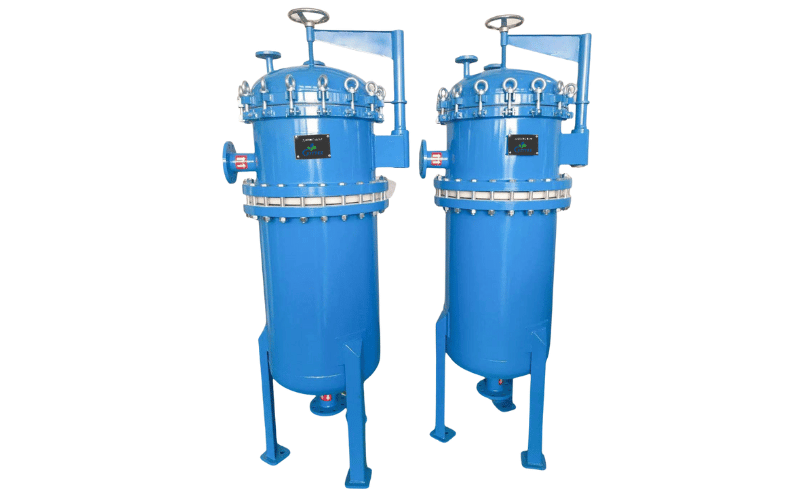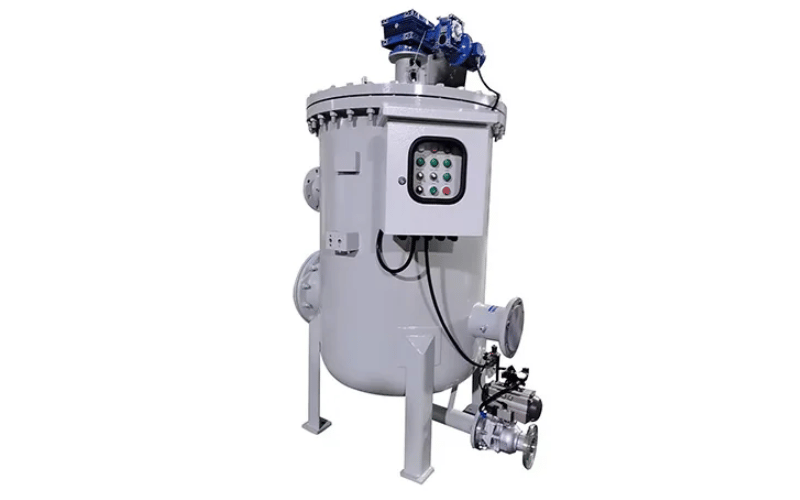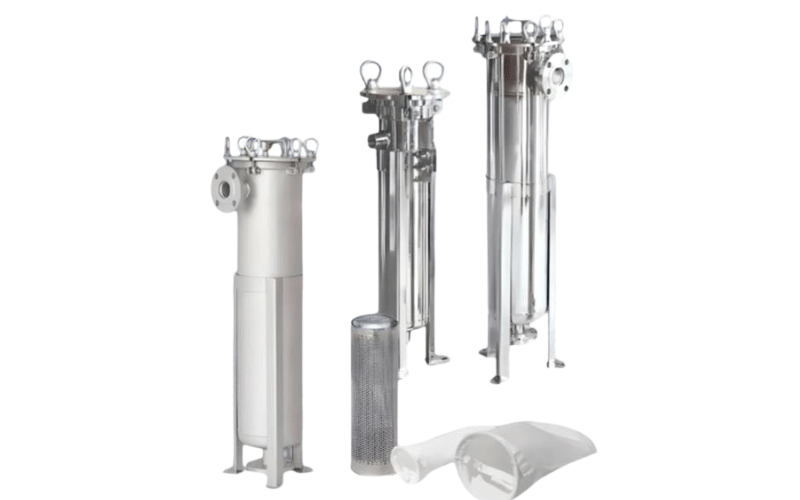Carbon Steel Bag Filter
Home » Filter Housing » Carbon Steel Bag Filter
Efficient Filtration | Long Service Life | Customizable Options
The Carbon Steel Bag Filter is primarily manufactured from carbon steel and can be customized into single-bag or multi-bag configurations, with further customization options available upon customer request. Carbon steel bag filters employ a side-in, bottom-out design; a side-in, side-out configuration is also available. The filtered liquid medium is pressurized or drawn into the filter housing via a pipeline. The liquid medium to be filtered passes through the filter bags supported by electro-polished perforated support frames, achieving ideal solid-liquid separation and effectively filtering the liquid medium.
Different filtration precisions depend on the precision of the filter bags. Since the liquid medium enters the filter from the top of the filter bag, it distributes evenly across the entire filtration surface of the bag, ensuring that the fluid distribution in the whole layer remains consistent and uniform. This minimizes the impact of turbulence, resulting in excellent filtration performance.
Technical Specifications
| Specifications and Models | Design pressure | Flow rate T/h | Inlet and outlet diameter |
|---|---|---|---|
| φ 159*250*1 bag | 0-1.6MPa | 5 | DN20 |
| φ 159*380*1 bag | 0-1.6MPa | 8 | DN25 |
| φ 219*410*1 bag | 0-1.6MPa | 15 | DN40 |
| φ 219*810*1 bag | 0-1.6MPa | 25 | DN50 |
| φ 300*810*1 bag | 0-1.6MPa | 35 | DN50 |
| φ 350*810*1 bag | 0-1.6MPa | 9 | DN65 |
| φ 400*810*2 bags | 0-1.6MPa | s 50 | DN65 |
| φ 450*810*3 bags | 0-1.6MPa | 75 | DN80 |
| φ 500*810*4 bags | 0-1.6MPa | 100 | DN100 |
| φ 550*810*5 bags | 0-1.6MPa | 125 | DN125 |
| φ 600*810*6 bags | 0-1.6MPa | 150 | DN150 |
| φ 700*810*7 bags | 0-1.6MPa | 175 | DN150 |
| φ 800*810*10 bags | 0-1.6MPa | 250 | DN200 |
| φ 900*810*14 bags | 0-1.6MPa | 300 | DN200 |
| φ 1000*810*18 bags | 0-1.6MPa | 400 | DN250 |
| φ 1200*810*24 bags | 0-1.6MPa | 600 | DN300 |
| φ 1400*810*36 bags | 0-1.6MPa | 800 | DN350 |
| Customized models and calibers available. For more details, please contact us. |
What are the Benefits of Using a Carbon Steel Filter?
When it comes to industrial filtration systems, the material used for the filter housing plays a crucial role in determining its performance, durability, and cost-effectiveness. Our carbon steel filters are designed to meet the demands of various applications, offering a perfect balance of strength, reliability, and affordability. Below, we explore the key benefits of using a carbon steel filter, touching on its durability, cost-effectiveness, and how it compares to stainless steel bag filters.
Durability and Strength of Carbon Steel in Filtration
Carbon steel is renowned for its exceptional mechanical strength and ability to perform under challenging conditions. Our carbon steel filters are designed to withstand high-pressure systems, ensuring they operate reliably even in demanding industrial environments. The robust nature of carbon steel means:
- Resistance to Physical Stress: Carbon steel can withstand high operating pressures and temperatures without warping or failing. This ensures the integrity of your filtration system in continuous or heavy-duty operations.
- Longevity in Tough Environments: Whether dealing with abrasive liquids, particulate matter, or high flow rates, our carbon steel filters provide reliability through their extended operational lifespan.
- Versatility Across Applications: From water treatment to petroleum processing, the strength and adaptability of carbon steel make it suitable for a range of industries.
We design our carbon steel housings with additional protective coatings or linings to enhance corrosion resistance, providing durability even in applications involving mildly corrosive substances.
Cost-Effectiveness of Carbon Steel Filter Housings
One of the standout advantages of choosing a carbon steel filter housing is its cost-effectiveness. We understand that operational budgets can be tight, and finding a reliable yet economical solution is often a top priority. Carbon steel filters provide:
- Lower Initial Investment: Compared to stainless steel, carbon steel is typically more affordable, making it an attractive option for industries that require efficient filtration at scale.
- Reduced Maintenance Costs: With proper coatings to prevent corrosion and wear, carbon steel housings require less frequent replacement or repair, minimizing long-term operational costs.
- High Value for Non-Corrosive Applications: If your application doesn’t involve highly aggressive chemicals or environments, carbon steel offers a durable option at a fraction of the cost of premium materials.
By selecting our carbon steel filters, you gain access to a budget-friendly solution that doesn’t compromise on reliability or filtration performance.
Comparison with Stainless Steel Bag Filters
While stainless steel and carbon steel filters both serve essential roles in industrial filtration, understanding their differences helps you choose the right solution for your needs. Below, we compare the two materials based on key performance factors:
1. Corrosion Resistance:
Stainless steel is widely regarded for its superior corrosion resistance, especially in environments involving acidic or highly saline liquids. Carbon steel, although less corrosion-resistant, becomes highly effective when properly coated. For projects where corrosion is not a significant concern or where coatings can suffice, carbon steel is a more economical choice.
2. Strength and Durability:
Both materials offer excellent mechanical strength; however, carbon steel demonstrates unparalleled toughness in handling physical stress and high-pressure environments. For heavy-duty applications, carbon steel filters often surpass expectations.
3. Cost and Accessibility:
While stainless steel commands a higher price due to its premium properties, carbon steel delivers similar durability at a much lower cost. When budget considerations are critical, carbon steel often proves to be the better option.
4. Applications:
Stainless steel is the material of choice for ultra-clean environments, such as food processing or pharmaceuticals, where frequent chemical exposure is a concern. Carbon steel, on the other hand, excels in general-purpose industrial environments, from manufacturing to water treatment.
By weighing these factors, we provide guidance on selecting the most practical option for your specific application requirements.
Final Thoughts
Opting for a carbon steel filter is a wise choice for industries that value strength, cost-efficiency, and versatility in their filtration systems. We’ve designed our carbon steel filters to deliver exceptional performance even in the most challenging conditions, ensuring your operations run smoothly and effectively. Whether you’re seeking a high-strength solution for high-pressure systems or considering the economic advantages of carbon steel over stainless steel, you can rely on us to help you make the right choice.
Our team is here to assist with any additional information you might need, including selecting the appropriate coatings or liners to meet your application’s unique demands. Discover the benefits of using our carbon steel filters today and experience the perfect balance of durability, performance, and cost-efficiency.

Maintenance Tips for Carbon Steel Bag Filter Housing
Proper maintenance of our carbon steel bag filter housings is critical for ensuring long-lasting performance and efficiency. With a proactive approach to routine maintenance, identifying and resolving common issues, and addressing replacement needs effectively, you can maximize the life and functionality of your filtration system. Below, we provide a comprehensive guide tailored to help you care for your carbon steel bag filter housing.
Routine Maintenance Practices to Ensure Longevity
Routine maintenance plays a vital role in the performance and durability of your carbon steel bag filter housing. We recommend incorporating the following practices into your maintenance schedule to keep the system in prime condition:
- Inspect Regularly: Conduct weekly inspections of the exterior and interior of the housing to identify any signs of wear, corrosion, or damage. Pay close attention to the sealing mechanism and pipe connections.
- Clean the Housing and Components: Remove any residual contaminants from the filter housing using a soft brush or a clean cloth. For stubborn deposits, use approved cleaning agents compatible with carbon steel to avoid damaging the surface.
- Check for Coating Integrity: Our carbon steel filter housings often feature protective coatings to resist corrosion. Periodically examine the coating for chips or cracks, especially if the system operates in environments with moisture or mild corrosive agents.
- Lubricate Sealing Components: Keep O-rings and gaskets properly lubricated to prevent wear and ensure an airtight seal. Use lubricant compatible with your processing fluid for optimal results.
- Monitor Pressure Differentials: Install pressure gauges to monitor inlet and outlet pressures. Sudden or excessive pressure buildups could indicate blockages or a need for filter bag replacement.
Carrying out these simple yet effective routines will help extend the service life of your equipment and maintain consistent filtration quality.
Identifying Common Issues in Filter Vessels
Even with regular maintenance, some issues may arise. Below are the most common problems associated with filter vessels and how they can be identified:
Corrosion or Rusting:
Cause: Exposure to moist or mildly corrosive environments.
Identification: Discoloration, pitting, or visible rust on the housing.
Tip: Address corrosion by reapplying protective coatings or linings wherever necessary.Leaks in the Housing:
Cause: Faulty seals, misaligned gaskets, or dried O-rings.
Identification: Presence of liquid around the seals or connections during operation.
Tip: Regularly check and replace worn-out gaskets and seals for leak-free performance.Clogged Flow Ports or Pipes:
Cause: Residual debris accumulating in ports or pipes.
Identification: Reduced flow rate or increased pressure differential.
Tip: Flush the system at intervals to remove any obstructions.Warping or Structural Weakness:
Cause: Operating at pressures or temperatures beyond recommended limits.
Identification: Visible deformities in the housing or diminished performance over time.
Tip: Always adhere to the operating specifications and schedule routine inspections.
By identifying and addressing these issues early, you can prevent potential downtime and ensure uninterrupted performance.
Replacement and Repair of Filter Bags and Parts
Timely replacement of filter bags and worn-out parts is an integral aspect of maintaining your system. Here’s how we recommend managing replacements and repairs:
Filter Bags:
Replace filter bags when you notice a significant pressure drop, reduced filtration efficiency, or visible damage such as tears or holes. Always ensure that the replacement bags match the system’s specifications to maintain proper fit and filtration accuracy.Seals and Gaskets:
Periodically check the condition of O-rings, gaskets, and other sealing components. Replace these parts immediately if they appear cracked, worn, or flattened to ensure the housing remains leak-proof.Support Basket Maintenance:
The support basket provides structural backing to the filter bag. Clean it thoroughly during each bag replacement to remove any residual debris or particles, and inspect for signs of wear that could compromise the filtration process. If necessary, replace the basket for consistent operational efficiency.Housing Repairs:
For chips, scratches, or minor corrosion on the housing’s surface, use approved repair solutions such as touch-up paints or patch kits. Severe damage may require replacement or professional reconditioning of the housing component.
By proactively managing replacements and repairs, you can avoid costly downtime and maintain consistent filtration performance.
Final Thoughts
Maintaining your carbon steel bag filter housing is a straightforward process when approached with regular inspections, routine cleaning, and timely replacements. By following our recommended maintenance practices, promptly identifying common issues, and addressing repair needs, you ensure that your system operates at peak performance. We’re here to provide guidance and support with maintenance tools, replacement parts, and expert advice to meet the unique requirements of your application. Trust us to help you get the most out of your carbon steel bag filter housing!
FAQs About Carbon Steel Bag Filter
Q: Can the filter vessel accommodate different types of baskets?
A: Yes, the filter vessel can accommodate a variety of baskets, including those made from 304 stainless steel or nylon monofilament, depending on the specific requirements of your application.
Q: Is the Carbon Steel Bag Filter Housing equipped for dual filtering?
A: Yes, the Carbon Steel Bag Filter Housing is available in a dual configuration, allowing for simultaneous filtration processes, which increases efficiency.
Q: What type of sealing mechanism is used in the filter housing?
A: The filter housing utilizes a reliable gasket seal, which ensures that there is no leakage during operation, maintaining the integrity of the filtration process.
Q: Does the filter vessel comply with any manufacturing standards?
A: Yes, the Carbon Steel Bag Filter Housing adheres to ASME code standards, ensuring that it meets the necessary safety and quality requirements for industrial equipment.
Q: What is the depth of the filter housing, and how does it affect the filtration process?
A: The depth of the filter housing is designed to hold a significant amount of loading, which contributes to the efficiency and longevity of the filtration process by allowing for extended service intervals.
Q: What types of liquids and gases can be filtered using this product?
A: The Carbon Steel Bag Filter Housing is suitable for filtering a variety of liquids and gases, including oil, water, and other chemicals, depending on the material compatibility of the selected filter bag.






